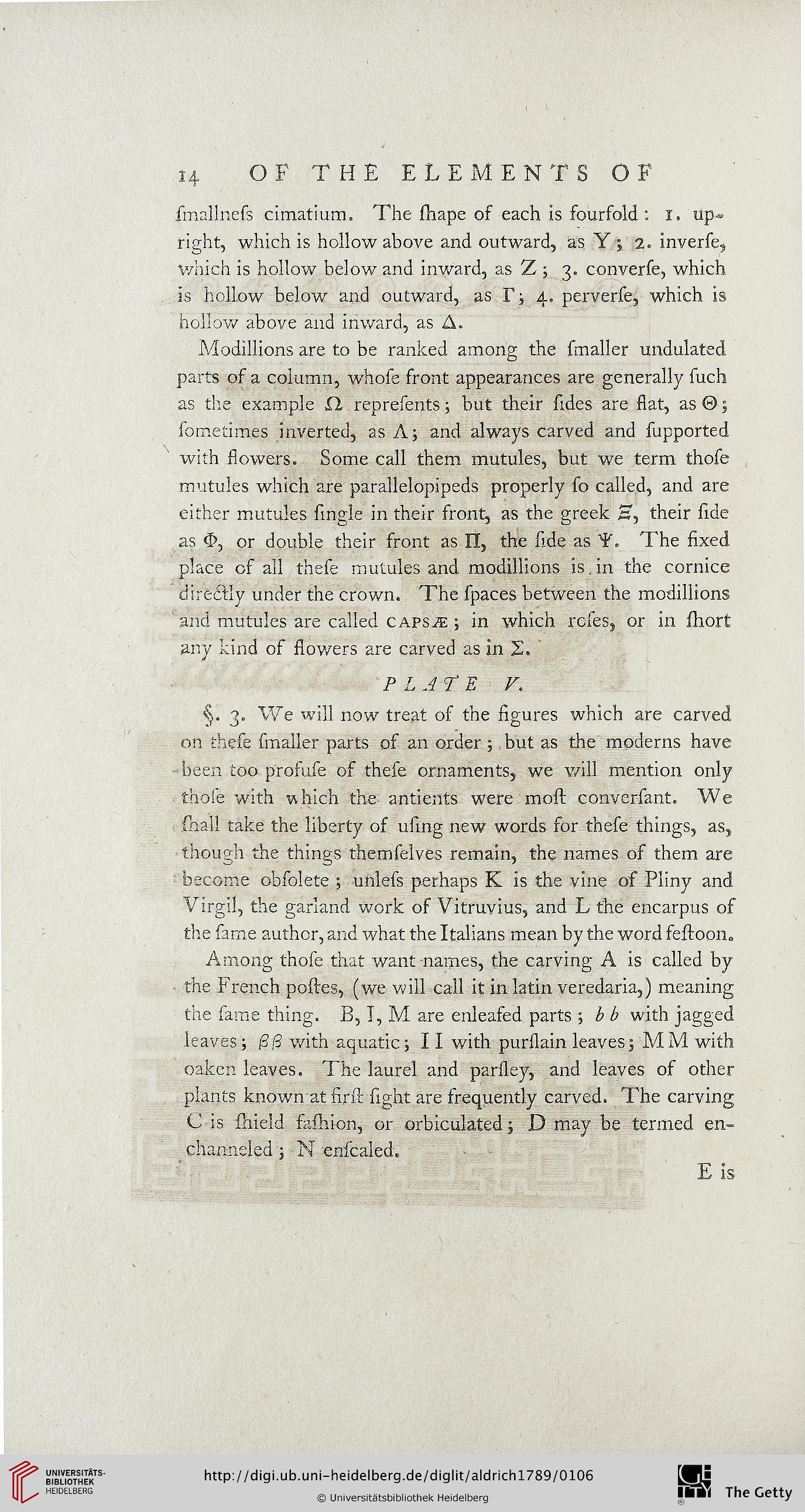i4 OF THE ELEMENTS OF
smallness cimatium. The shape of each is fourfold: i. up*
right, which is hollow above and outward, as Y ; 2. inverse,
which is hollow below and inward, as Z; 3. converse, which
is hollow below and outward, as F ; 4. perverse, which is
hollow above and inward, as A.
Modiilions are to be ranked among the smaller undulated
parts of a column, whose front appearances are generally such
as the example 12 represents; but their sides are siat, as ©;
sometimes inverted, as A; and always carved and supported
with flowers. Some call them mutules, but we term those
mutules which are parallelopipeds properly so called, and are
either mutules Single in their front, as the greek H, their side
as or double their front as II, the side as T. The fixed
place of all these mutules and modiilions is in the cornice
direTIy under the crown. The spaces between the modiilions
and mutules are called CAPSiE ; in which rcses, or in short
any kind of ssowers are carved as in 2.
PLATE V.
3. We will now treat of the figures which are carved
on these smaller parts os an order ; but as the moderns have
-been too profuse of these ornaments, we will mention only
those with which the antients were molt conversant. We
(ball take the liberty of using new words sor these things, as,
though the things themselves remain, the names of them are
: become obsolete ; unless perhaps K is the vine of Pliny and
Virgil, the garland work of Vitruvius, and L the encarpus os
the same author, and what the Italians mean by the word festoon.
Among those that want names, the carving A is called by
the French postes, (we will call it in latin veredaria,) meaning
the same thing. B, I, M are enleafed parts ; b b with jagged
leaves; (3/3 with aquatic; 11 with purssain. leaves; MM with
oaken leaves. The laurel and parsley, and leaves of other
plants known at sirsi: sight are frequently carved. The carving
C is shield fashion, or orbiculated; D may be termed en«
channeled; N enscaled.
E is
smallness cimatium. The shape of each is fourfold: i. up*
right, which is hollow above and outward, as Y ; 2. inverse,
which is hollow below and inward, as Z; 3. converse, which
is hollow below and outward, as F ; 4. perverse, which is
hollow above and inward, as A.
Modiilions are to be ranked among the smaller undulated
parts of a column, whose front appearances are generally such
as the example 12 represents; but their sides are siat, as ©;
sometimes inverted, as A; and always carved and supported
with flowers. Some call them mutules, but we term those
mutules which are parallelopipeds properly so called, and are
either mutules Single in their front, as the greek H, their side
as or double their front as II, the side as T. The fixed
place of all these mutules and modiilions is in the cornice
direTIy under the crown. The spaces between the modiilions
and mutules are called CAPSiE ; in which rcses, or in short
any kind of ssowers are carved as in 2.
PLATE V.
3. We will now treat of the figures which are carved
on these smaller parts os an order ; but as the moderns have
-been too profuse of these ornaments, we will mention only
those with which the antients were molt conversant. We
(ball take the liberty of using new words sor these things, as,
though the things themselves remain, the names of them are
: become obsolete ; unless perhaps K is the vine of Pliny and
Virgil, the garland work of Vitruvius, and L the encarpus os
the same author, and what the Italians mean by the word festoon.
Among those that want names, the carving A is called by
the French postes, (we will call it in latin veredaria,) meaning
the same thing. B, I, M are enleafed parts ; b b with jagged
leaves; (3/3 with aquatic; 11 with purssain. leaves; MM with
oaken leaves. The laurel and parsley, and leaves of other
plants known at sirsi: sight are frequently carved. The carving
C is shield fashion, or orbiculated; D may be termed en«
channeled; N enscaled.
E is




